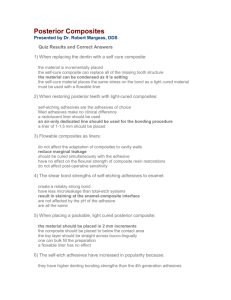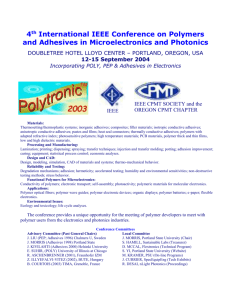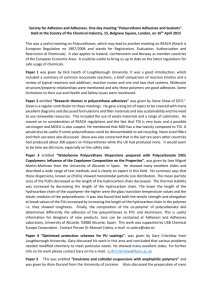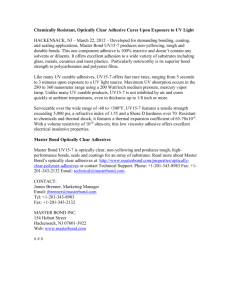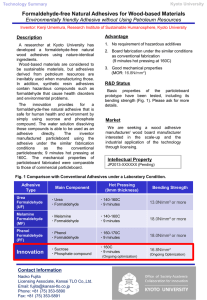US Proposal
advertisement
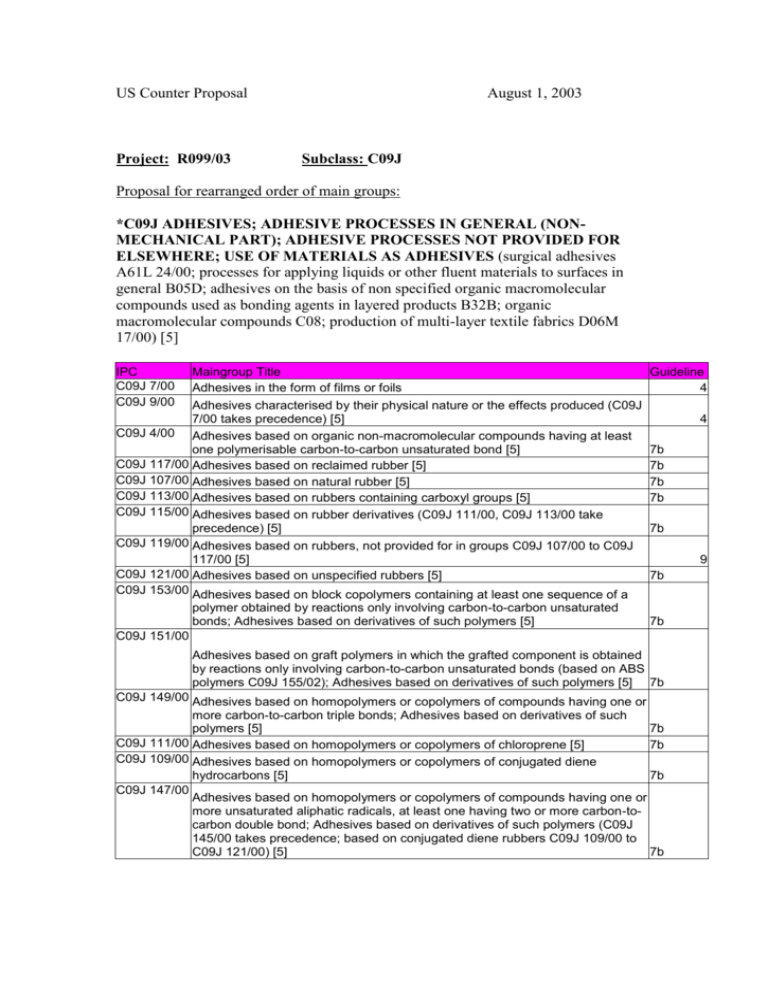
US Counter Proposal Project: R099/03 August 1, 2003 Subclass: C09J Proposal for rearranged order of main groups: *C09J ADHESIVES; ADHESIVE PROCESSES IN GENERAL (NONMECHANICAL PART); ADHESIVE PROCESSES NOT PROVIDED FOR ELSEWHERE; USE OF MATERIALS AS ADHESIVES (surgical adhesives A61L 24/00; processes for applying liquids or other fluent materials to surfaces in general B05D; adhesives on the basis of non specified organic macromolecular compounds used as bonding agents in layered products B32B; organic macromolecular compounds C08; production of multi-layer textile fabrics D06M 17/00) [5] IPC C09J 7/00 C09J 9/00 Maingroup Title Adhesives in the form of films or foils Adhesives characterised by their physical nature or the effects produced (C09J 7/00 takes precedence) [5] C09J 4/00 Adhesives based on organic non-macromolecular compounds having at least one polymerisable carbon-to-carbon unsaturated bond [5] C09J 117/00 Adhesives based on reclaimed rubber [5] C09J 107/00 Adhesives based on natural rubber [5] C09J 113/00 Adhesives based on rubbers containing carboxyl groups [5] C09J 115/00 Adhesives based on rubber derivatives (C09J 111/00, C09J 113/00 take precedence) [5] C09J 119/00 Adhesives based on rubbers, not provided for in groups C09J 107/00 to C09J 117/00 [5] C09J 121/00 Adhesives based on unspecified rubbers [5] C09J 153/00 Adhesives based on block copolymers containing at least one sequence of a polymer obtained by reactions only involving carbon-to-carbon unsaturated bonds; Adhesives based on derivatives of such polymers [5] Guideline 4 4 7b 7b 7b 7b 7b 9 7b 7b C09J 151/00 Adhesives based on graft polymers in which the grafted component is obtained by reactions only involving carbon-to-carbon unsaturated bonds (based on ABS polymers C09J 155/02); Adhesives based on derivatives of such polymers [5] 7b C09J 149/00 Adhesives based on homopolymers or copolymers of compounds having one or more carbon-to-carbon triple bonds; Adhesives based on derivatives of such polymers [5] 7b C09J 111/00 Adhesives based on homopolymers or copolymers of chloroprene [5] 7b C09J 109/00 Adhesives based on homopolymers or copolymers of conjugated diene hydrocarbons [5] 7b C09J 147/00 Adhesives based on homopolymers or copolymers of compounds having one or more unsaturated aliphatic radicals, at least one having two or more carbon-tocarbon double bond; Adhesives based on derivatives of such polymers (C09J 145/00 takes precedence; based on conjugated diene rubbers C09J 109/00 to C09J 121/00) [5] 7b C09J 143/00 C09J 141/00 C09J 139/00 C09J 137/00 C09J 145/00 C09J 135/00 C09J 133/00 C09J 131/00 C09J 129/00 Adhesives based on homopolymers or copolymers of compounds having one or more unsaturated aliphatic radicals, each having only one carbon-to-carbon double bond, and containing boron, silicon, phosphorus, selenium, tellurium, or a metal; Adhesives based on derivatives of such polymers (based on metal salt derivatives of polymers, e.g. phenolates, alcoholates, see the adhesives based on the parent compounds) [5] 7b Adhesives based on homopolymers or copolymers of compounds having one or more unsaturated aliphatic radicals, each having only one carbon-to-carbon double bond, and at least one being terminated by a bond to sulfur or by a heterocyclic ring containing sulfur; Adhesives based on derivatives of such polymers [5] 7b Adhesives based on homopolymers or copolymers of compounds having one or more unsaturated aliphatic radicals, each having only one carbon-to-carbon double bond, and at least one being terminated by a single or double bond to nitrogen or by a heterocyclic ring containing nitrogen; Adhesives based on derivatives of such polymers [5] 7b Adhesives based on homopolymers or copolymers of compounds having one or more unsaturated aliphatic radicals, each having only one carbon-to-carbon double bond, and at least one being terminated by a heterocyclic ring containing oxygen (based on polymers of cyclic esters of polyfunctional acids C09J 131/00; based on polymers of cyclic anhydrides of unsaturated acids C09J 135/00); Adhesives based on derivatives of such polymers [5] 7b Adhesives based on homopolymers or copolymers of compounds having no unsaturated aliphatic radicals in a side chain, and having one or more carbonto-carbon double bonds in a carbocyclic or in a heterocyclic ring system; Adhesives based on derivatives of such polymers (based on polymers of cyclic esters of polyfunctional acids C09J 131/00; based on polymers of cyclic anhydrides or imides C09J 135/00) [5] 7b Adhesives based on homopolymers or copolymers of compounds having one or more unsaturated aliphatic radicals, each having only one carbon-to-carbon double bond, and at least one being terminated by a carboxyl radical, and containing at least another carboxyl radical in the molecule, or of salts, anhydrides, esters, amides, imides or nitriles thereof; Adhesives based on derivatives of such polymers [5] 7b Adhesives based on homopolymers or copolymers of compounds having one or more unsaturated aliphatic radicals, each having only one carbon-to-carbon double bond, and at least one being terminated by only one carboxyl radical, or of salts, anhydrides, esters, amides, imides, or nitriles thereof; Adhesives based on derivatives of such polymers [5] 7b Adhesives based on homopolymers or copolymers of compounds having one or more unsaturated aliphatic radicals, each having only one carbon-to-carbon double bond, and at least one being terminated by an acyloxy radical of a saturated carboxylic acid, of carbonic acid, or of a haloformic acid (based on hydrolysed polymers C09J 129/00); Adhesives based on derivatives of such polymers [5] 7b Adhesives based on homopolymers or copolymers of compounds having one or more unsaturated aliphatic radicals, each having only one carbon-to-carbon double bond, and at least one being terminated by an alcohol, ether, aldehydo, ketonic, acetal, or ketal radical; Adhesives based on hydrolysed polymers of esters of unsaturated alcohols with saturated carboxylic acids; Adhesives based on derivatives of such polymers [5] 7b C09J 127/00 Adhesives based on homopolymers or copolymers of compounds having one or more unsaturated aliphatic radicals, each having only one carbon-to-carbon double bond, and at least one being terminated by a halogen; Adhesives based on derivatives of such polymers [5] 7b C09J 125/00 Adhesives based on homopolymers or copolymers of compounds having one or more unsaturated aliphatic radicals, each having only one carbon-to-carbon double bond, and at least one being terminated by an aromatic carbocyclic ring; Adhesives based on derivatives of such polymers [5] 7b C09J 123/00 Adhesives based on homopolymers or copolymers of unsaturated aliphatic hydrocarbons having only one carbon-to-carbon double bond; Adhesives based on derivatives of such polymers [5] 7b C09J 155/00 Adhesives based on homopolymers or copolymers, obtained by polymerisation reactions only involving carbon-to-carbon unsaturated bonds, not provided for in groups C09J 123/00 to C09J 153/00 [5] C09J 157/00 Adhesives based on unspecified polymers obtained by reactions only involving carbon-to-carbon unsaturated bonds [5] 7b C09J 159/00 Adhesives based on polyacetals; Adhesives based on derivatives of polyacetals [5] 7b C09J 161/00 Adhesives based on condensation polymers of aldehydes or ketones (with 9 polyalcohols C09J 159/00; with polynitriles C09J 177/00); Adhesives based on derivatives of such polymers [5] 7b C09J 163/00 Adhesives based on epoxy resins; Adhesives based on derivatives of epoxy resins [5] 7b C09J 165/00 Adhesives based on macromolecular compounds obtained by reactions forming a carbon-to-carbon link in the main chain (C09J 107/00 to C09J 157/00, C09J 161/00 take precedence); Adhesives based on derivatives of such polymers [5] 7b C09J 167/00 Adhesives based on polyesters obtained by reactions forming a carboxylic ester link in the main chain (based on polyester-amides C09J 177/12; based on polyester-imides C09J 179/08); Adhesives based on derivatives of such polymers [5] 7b C09J 169/00 Adhesives based on polycarbonates; Adhesives based on derivatives of polycarbonates [5] 7b C09J 171/00 Adhesives based on polyethers obtained by reactions forming an ether link in the main chain (based on polyacetals C09J 159/00; based on epoxy resins C09J 163/00; based on polythioether-ethers C09J 181/02; based on polyethersulfones C09J 181/06); Adhesives based on derivatives of such polymers [5] 7b C09J 173/00 Adhesives based on macromolecular compounds obtained by reactions forming a linkage containing oxygen or oxygen and carbon in the main chain, not provided for in groups C09J 159/00 to C09J 171/00; Adhesives based on derivatives of such polymers [5] C09J 175/00 Adhesives based on polyureas or polyurethanes; Adhesives based on derivatives of such polymers [5] C09J 177/00 Adhesives based on polyamides obtained by reactions forming a carboxylic 9 7b amide link in the main chain (based on polyhydrazides C09J 179/06; based on polyamide-imides C09J 179/08); Adhesives based on derivatives of such polymers [5] 7b C09J 179/00 Adhesives based on macromolecular compounds obtained by reactions forming in the main chain of the macromolecule a linkage containing nitrogen, with or without oxygen, or carbon only, not provided for in groups C09J 161/00 to C09J 177/00 [5] 9 C09J 181/00 Adhesives based on macromolecular compounds obtained by reactions forming in the main chain of the macromolecule a linkage containing sulfur, with or without nitrogen, oxygen, or carbon only; Adhesives based on polysulfones; Adhesives based on derivatives of such polymers [5] 7b C09J 183/00 Adhesives based on macromolecular compounds obtained by reactions forming in the main chain of the macromolecule a linkage containing silicon, with or without sulfur, nitrogen, oxygen, or carbon only; Adhesives based on derivatives of such polymers [5] 7b C09J 185/00 Adhesives based on macromolecular compounds obtained by reactions forming in the main chain of the macromolecule a linkage containing atoms other than silicon, sulfur, nitrogen, oxygen, and carbon; Adhesives based on derivatives of such polymers [5] 7b C09J 187/00 Adhesives based on unspecified macromolecular compounds, obtained otherwise than by polymerisation reactions only involving unsaturated carbonto-carbon-bonds [5] 7b C09J 103/00 Adhesives based on starch, amylose or amylopectin or on their derivatives or degradation products [5] 7b C09J 101/00 Adhesives based on cellulose, modified cellulose, or cellulose derivatives [5] 7b C09J 105/00 Adhesives based on polysaccharides or on their derivatives, not provided for in groups C09J 101/00 or C09J 103/00 [5] C09J 189/00 Adhesives based on proteins; Adhesives based on derivatives thereof (foodstuff preparations A23J 3/00) [5] 7b C09J 191/00 Adhesives based on oils, fats or waxes; Adhesives based on derivatives thereof (polishing compositions, ski waxes C09G; soaps, detergent compositions C11D) [5] C09J 193/00 Adhesives based on natural resins; Adhesives based on derivatives thereof (polishing compositions C09G) [5] C09J 195/00 Adhesives based on bituminous materials, e.g. asphalt, tar, pitch [5] C09J 197/00 Adhesives based on lignin-containing materials [5] C09J 199/00 Adhesives based on natural macromolecular compounds or on derivatives thereof, not provided for in groups C09J 189/00 to C09J 197/00 [5] C09J 201/00 Adhesives based on unspecified macromolecular compounds [5] C09J 1/00 Adhesives based on inorganic constituents C09J 5/00 Adhesive processes in general; Adhesive processes not provided for elsewhere (devices for applying glue to surfaces to be joined B05, B27G 11/00) C09J 11/00 Other features, e.g. additives [5] Comments: Above is the US counter proposal to Rapporteur’s arrangement of Annex 1. We placed the two special groups first and positioned the remaining groups to minimize overlap and to take precedence references or residual-type groups into account, when possible. Note that we did not position group 111/00 above 115/00 though a precedence reference exists in 115/00. It seemed more appropriate to keep all of the rubber-related main groups together and put group 111/00 (Compositions of homopolymers or copolymers of chloroprene) with the homopolymers or copolymers groups. Since the precedence note still exists in the group 115/00 title, classifications will still be made appropriately. Additionally, we attempted to make the main group order of subclasses C08L, C09D, and C09J consistent for ease of use. These 3 subclasses have similarly worded groups making this possible. 9 7b 7b 7b 7b 9 7b 7b 9 9 A question as to why we placed group 1/00 near the bottom of the arrangement may be raised so our explanation follows. According to (2) note after the subclass title, non-macromolecular substances are not taken into account when classifying compositions containing macromolecular substances. Therefore, any composition with a macromolecular substance and an inorganic substance, even if it is based on the inorganic substance, should be classified in the macromolecular groups. We have placed them first so that classifiers/examiners will not be tempted to put such compositions in 1/00, which might happen if 1/00 is placed first or high in the arrangement. The only compositions that would make it to 1/00 when it is positioned low in the scheme are those that have no macromolecular substance and are based on an inorganic substance. We assumed that this is the type of subject matter that should go in 1/00. If we have misinterpreted the intent of the (2) note, we can reposition 1/00 in the arrangement. A new residual group may be needed for a combination of a non-macromolecular organic compound and an inorganic material, wherein the non-macromolecular organic material is in the highest proportion (based), or for a composition containing only non-macromolecular organic materials.
